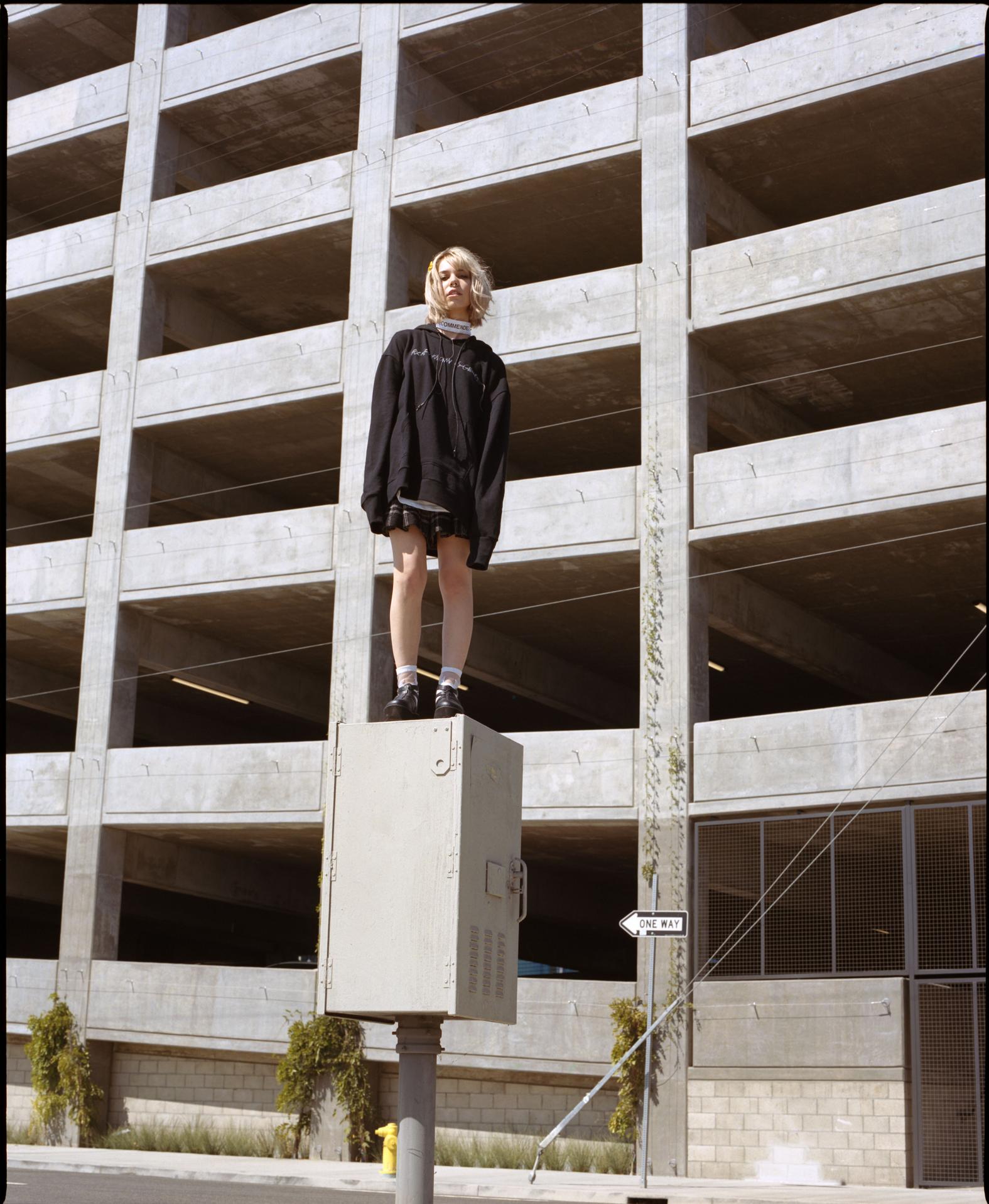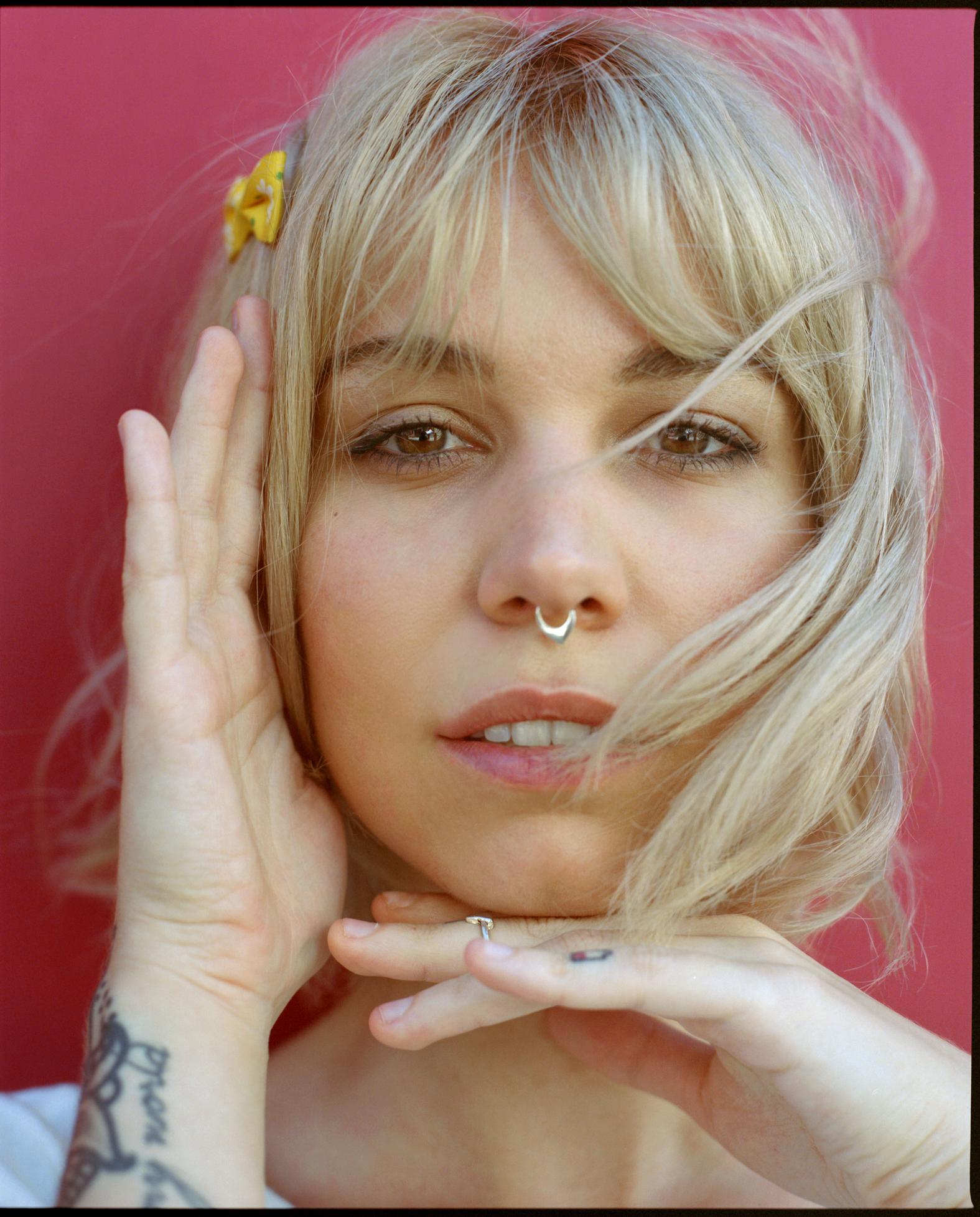This story appears in VICE magazine and Noisey’s 2017 Music Issue. Click HEREto subscribe to VICE magazine.
The story most often told about Mija finds her at Bonnaroo in 2014, moments away from kicking off her sunrise set atop Kalliope, a laser-blasting, festival-touring mobile stage (recently seen at Electric Daisy Carnival) that looks like a gypsy wagon crossed with a boom box. Skrillex, driving past in a golf cart, saw this bacchanalian monstrosity, joined the party, and at Mija’s invitation, did a back-to-back deep-house set with her that went viral and launched the career of a promising new DJ talent.
Videos by VICE
It’s no fairy tale—that did happen—but it’s a bit too princess-in-a-tower to define a person with as much born hustle and drive as Amber Giles, now 25, who sat with me in August at the hip and airy Zinc Cafe in Los Angeles’s Arts District. For a more elucidating Mija-meets-Skrillex anecdote, rewind to when she was 18, a self-made rave promoter in the Arizona underground. She usually ferried the DJs she booked straight from the airport to their hotel in her 2001 Honda Accord, but when a pre-fame Skrillex arrived, she was his white knight: “I drove him to get sushi, took him to Hot Topic to get [ear] gauges, and sewed his pants because he had a giant hole in the crotch.”
Mija sipped her iced coffee, cream still swirling in the plastic cup, with perfect nonchalance, as if helping a future EDM kingmaker (and present-day pal) get his shit together is a normal thing for one to do before graduating high school. For her it was—we’ll get back to that—which makes it only slightly easier to understand how nearly three years after moving from Phoenix to LA with no plan and little money, Mija’s poised to become one of the biggest names in contemporary dance music, as well as a one-woman art factory.
“I’ve always been into super upbeat, cute, uplifting progressions, but at the same time, I’m also a very dark person.”
The lead single from her self-released debut is available this fall, but she hasn’t been shut away in the studio. Last fall, she curated and led the insane “Fk a Genre” tour, with a rotating lineup that included A-Trak, Kill the Noise, Anna Lunoe, Lunice, and 25 others. (“I think my agent wanted to kill me,” she said.) Then she launched the goth-ish, rave-friendly Made by Mija clothing line—with everything from beanies to bombers to bras—which she plans to improve by being even more hands-on (“I want to make it more high-end by sewing things myself,” she said). And there’s “Time Stops,” an animated short she co-wrote with her frequent collaborator, the musician Ryan Forever. Her original score smashes trap, ambient, and pop into an 8-bit happy hardcore frame. As for the narrative…
“It starts with this girl who’s in her room talking to some guy she likes,” she told me. “And she gets disconnected from him, so he starts riding his bike to her house as fast as he can. Then he gets hit by a car.” She let out a high-pitched giggle that was more than a little disconcerting. There’s a sci-fi twist that allows the character to live on in digitized form (whew), but this may be a good time to point out the gruesome oversize Slayer tee she was wearing during our conversation and the outfit she’d built around it: a yellow skirt, checkered Vans slip-ons, a golden teardrop septum ring, opalescent shades, and topping her shaggy purple-silver bob, a tiny yellow bow. She was the living embodiment of the fuzzy, $2,500 USD, monster-faced Fendi backpack she’d draped over her chair: compact and quietly menacing.

To date, her music has tread a similar line. Take January’s “Secrets,” in which a chipmunk-sounding Tegan & Sara sample flits merrily through a hostile soundscape of robotic rumble, drum ‘n’ bass sputter, and zero-gravity dub, or her and Vindata’s moody cheer-bomb “Better,” or her trap-pop remix of Major Lazer’s “Be Together.” “I’ve always been into super upbeat, cute, uplifting progressions, but at the same time, I’m also a very dark person,” she told me. “I really like both sides, and I feel like I’m always trying to find some middle ground with music, or style, or anything that I do.”
Seesawing has always been her thing. Childhood wasn’t exactly a breeze—her mom was single and barely 18 when she had Mija and made ends meet via “pest control and random gigs.” Still, Mija sang constantly as a kid. She remembers crooning over a restaurant PA at five when a waiter handed her a mic, and at seven, she joined the Phoenix Girls Chorus, with whom she’d hear her voice echoing off the vaulted ceiling of Notre-Dame in Paris. Back home, though, “middle and high school sucked.” Her mother got her into school in a wealthy area so she’d have better opportunities, but Mija felt out of place. So she looked for her people elsewhere and found them at illegal warehouse parties—the first of which she attended at the age of 15.
“It blew my mind that there was this entire community I knew nothing about with an ideology I’d never experienced in my neighborhood or with my family. It was very PLUR,” Mija said, laughing. “But imagine how much that resonates with you at that age when you start understanding the world around you, how things interact with each other, and the crazy mean things that happen along with the beauty and love. You want to be a part of something, to feel like this is a movement!”
The seesaw dipped back down pretty quickly when Mija was expelled for a year. “I got searched, and I got kicked out,” is all she said. She’d return to graduate, but not before being voted “Most Likely to End Up on the Streets,” probably because of her raver pants and pink pigtails. The joke was on her classmates—she not only scored straight A’s but became a businesswoman in her time off.
Mija had to lie about her age to get her first full-time job, but by the time she was actually of legal working age (16), she’d made supervisor at a pottery painting shop and convinced her boss to buy her Heelys (the wheel-affixed sneakers popular with local ravers), so she could attend to customers quickly. By 17, she was using the shoes to distribute flyers to the parties she was then hosting and making up to $10,000 in a night, she said, or losing as much investing in someone else’s event. After too much gambling as a promoter, Mija decided she needed to be paid to play music instead.
After graduating in 2010, she DJed nights while splitting her days between fashion school and a T-shirt-printing shop, then scored a twice-weekly residency spinning at the Sheraton in downtown Phoenix that paid more than the day job ever could have. She eventually quit everything else and, about a week before that 2014 set at Bonnaroo, bought Ableton production software, an Akai keyboard/beat station, and a pair of studio monitors to begin her transition to producer. Around that time, “[Skrillex] said, ‘You need to move to downtown LA.’ And I was like, ‘OK! Alright! Let’s do it!’”
Life in this part of town—scruffy, fashionable, urban, arty—suits her. She skates (short cruiser); meditates (via the Headspace app); paints (most recently the solar eclipse); smokes (Turkish Royals); reads poetry (Rupi Kaur), and writes it, too. Her neighbors are fellow bleeding-edge DJ-producers like Ghastly, Jauz, and Kayzo. There are warehouses galore just begging for parties. Mija’s made it her home. But settling into a sound as an artist, especially as a DJ with a known disdain for genre lines, has taken a little more work.
“I realized you can be the dopest producer technically, but if the songs don’t give you emotion, it doesn’t matter,” said Mija. “I wasn’t good at writing big banger tracks because that wasn’t in my heart. The music coming out of me now isn’t even dance music. I’m using my own vocals for the first time, taking piano lessons, and playing more. It’s not entirely DJ-able. It’s just who I am.”

And so far, it’s quite good. The one song I heard, “Bad For U,” from her self-released EP, How to Measure the Distance Between Lovers, plays like future blues, fusing the uncanny effects of Oneohtrix Point Never with the bass-scaping of Burial and the crystalline beauty of Björk. A woman’s voice, otherworldly yet warm, coos, “This world is bad for you, and it’s bad for me too, but we’re so lucky / I hear it all the time, as if being lucky must have just slipped our minds.”
Rather than rehash feel-good EDM-platitudes, Mija said she’s been mining other emotions: anxiety about the state of, well, everything. It’s fitting, then, that her favorite tattoo (of about a dozen that are visible) is the first line of Charles Bukowski’s end-times poem “Dinosauria, We, “ etched in block letters on her left forearm. “Born like this, into this,” it reads, implying that humanity’s self-imposed apocalypse is predestined. Considering the peculiar ambition of Mija—a combination of entropy and DIY grind—not to mention her macabre sense of humor, it’d also be a pretty perfect way to describe her journey to now.
Chris Martins is a writer based in California. Follow him on Twitter.
More
From VICE
-

Screenshot: Infold Games -

Collage by VICE -

Photo by Morten Falch Sortland -

